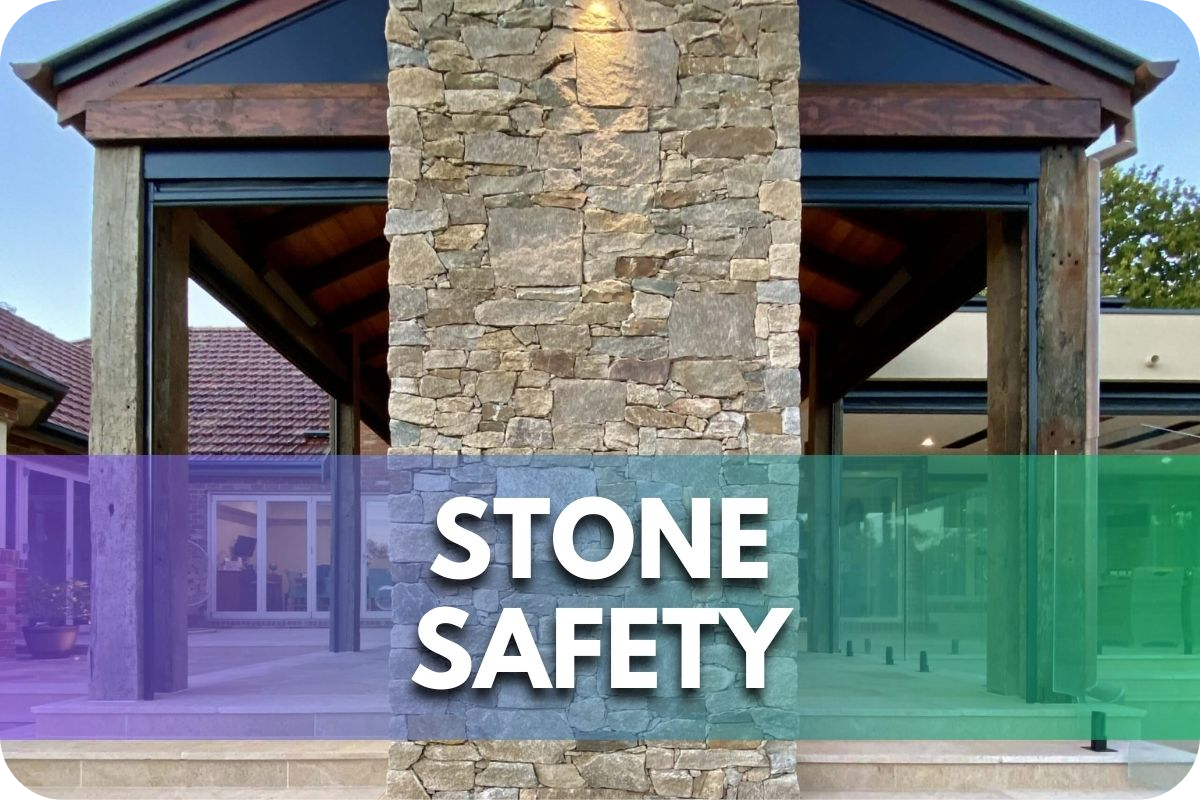
Working with heavy stone materials can pose significant risks of injury if not handled and installed properly.
Improper lifting techniques, inadequate protective equipment, and lack of safety precautions can lead to severe back injuries, crushed limbs, or even fatal accidents.
This article provides essential guidelines for safe stone handling and installation. It covers proper lifting methods, personal protective equipment (PPE), and crucial safety measures to prevent injuries and ensure a secure working environment.
Assessing Risks in Stone Handling and Installation
Stoneworking, while beautiful and functional, comes with inherent risks. To ensure a safe work environment, understanding these risks is vital.
1. Heavy Lifting Hazards
- Injuries: Lifting heavy stone pieces can lead to strains, sprains, back injuries, or crushed limbs if proper protocols aren’t followed.
- Prevention: Utilize mechanical lifting equipment (dollies, vacuum lifters), ensure enough workers share the load, and follow ergonomic lifting techniques (bend knees, not back).
2. Sharp Edges and Corners
- Injuries: Cuts, lacerations, and punctures can easily occur from handling stones with sharp edges and corners.
- Prevention: Wear thick, cut-resistant gloves. Use padding on stone edges during transport, and be mindful when installing pieces with sharp angles.
3. Dust Inhalation
- Injuries: Silica dust, generated while cutting or shaping stone, can cause serious lung diseases like silicosis.
- Prevention: Use wet-cutting methods to suppress dust, wear proper respiratory protection (masks or respirators), and ensure good ventilation.
4. Noise Exposure
Injuries: Stone cutting and grinding generate loud noise, which can potentially cause hearing loss. Prevention: Wear mandatory hearing protection (earplugs or earmuffs) and limit exposure to noisy machinery.
Safety Precautions for Stone Handling
Prevention is key to avoiding injuries when handling stones. Follow these crucial precautions:
1. Proper Lifting Techniques
- Bend with your knees: Squat down with your knees bent, not your back. Keep your back straight and core engaged.
- Lift with your legs: Power the lift from your leg muscles, not your back.
- Teamwork: For heavier loads, coordinate with team members for a synchronized lift and safe distribution of weight.
- Mechanical aids: To minimize manual strain, use dollies, vacuum lifters, or forklifts (with proper attachments) whenever possible.
2. Personal Protective Equipment (PPE)
- Gloves: Choose cut-resistant gloves to protect hands from sharp edges and corners.
- Safety glasses/goggles: Shield your eyes from dust, chips, and flying debris.
- Steel-toed boots: Protect feet from dropped materials or crushing injuries.
- Optional: Consider knee pads for extended periods of kneeling.
3. Secure Storage and Transportation
- Stable surfaces: Use A-frame racks specifically designed for stone slabs.
- Strap down: Secure materials with strong straps/ratchets during transport, preventing shifting.
- Utilize proper equipment: Use forklifts with suitable attachments, vacuum lifters designed for stone, or specifically designed dollies for moving slabs.
4. Dust Control
- Wet cutting: Use wet saws to reduce airborne silica dust significantly.
- Respiratory protection: Wear appropriate respirators or dust masks designed for silica protection.
5. Work Area Awareness
- Clear walkways: Keep work areas clean and free of debris to minimize trip hazards.
- Fall protection: When working at heights, utilize fall harnesses and secure anchor points.
Safety Measures for Stone Installation
A safe worksite is crucial during the installation phase. Implement these measures for accident prevention:
1. Proper Tool Use and Maintenance
- Training: Ensure workers are well-trained in correctly using power saws, grinders, mixers, and any specialized stone installation tools.
- Maintenance: Keep tools sharp and in good repair. Dull or damaged tools are more likely to cause accidents.
- Follow guidelines: Always adhere to the manufacturer’s instructions and safety protocols when operating tools.
2. Workspace Organization
- Clear pathways: Maintain clean, uncluttered walkways to prevent trips and falls.
- Store materials properly: Stack materials securely, away from high-traffic areas.
- Tool management: Designate areas for tools when not in use, preventing them from becoming hazards.
3. Risk Assessment and Planning
- Identify potential hazards: Analyze the workspace for uneven surfaces, electrical hazards, potential overhead risks, or nearby traffic.
- Develop a plan: Create a safety plan outlining specific precautions for each identified hazard. Communicate this plan to all workers.
- Contingency preparation: Plan for unexpected events (broken slabs, tool malfunctions) to minimize delays and safety risks.
4. Secure Installation Area
- Barricades: If necessary, use barriers or highly visible tape to cordon off the installation area, preventing unauthorized access.
- Ground stability: Verify the ground or scaffolding is stable and can support the weight of stone and workers.
5. Noise and Dust Protection:
- Hearing protection: Require earplugs or earmuffs in areas with loud machinery.
- Dust control: Continue wet-cutting methods and/or use dust collection systems where possible. Utilize proper respirators.
Conclusion
Stone’s beauty and versatility are undeniable, but working with it requires careful attention to safety. By understanding the risks, using proper lifting techniques, wearing PPE, and maintaining a safe workspace, you significantly reduce the potential for injuries.
Don’t compromise on safety – make it a cornerstone of your stonework.
Contact Splendour In Stone Melbourne for tailored advice and expert assistance in creating the safest stone handling and installation practices.
More To Explore

Stone Accents: Adding Charm to Modern Interiors with Natural Stone
Modern interiors seek a balance of style, durability, and uniqueness. Natural stone accents are a game-changer, adding timeless elegance and character to any space. As

Natural Stone Features That Will Transform Your Living Room
Natural stone elevates any living room with elegance, texture, and timeless appeal. Its versatility allows it to enhance both modern and traditional spaces. From stone


